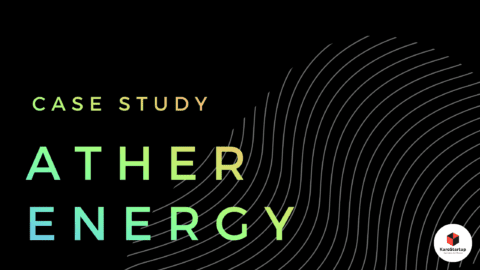Business Model of Ather Energy: Insights and Growth Projections
Introduction to the Business Model of Ather Energy
Ather Energy is an Indian electric vehicle (EV) manufacturer that was founded in 2013 by Tarun Mehta and Swapnil Jain, two IIT Madras graduates. Known for its smart electric scooters, Ather is at the forefront of revolutionizing urban mobility in India. With advanced models like the Ather 450X and Ather 450 Plus, the company has established itself as a premium brand, offering eco-friendly transportation alternatives that come with cutting-edge technology and smart features such as touchscreen dashboards and over-the-air software updates. The business model of Ather Energy is designed to blend performance with technological innovation, catering to a growing market for sustainable transportation.
Key Analysis: Business Model of Ather Energy
Business Model Overview
The business model of Ather Energy is built on delivering high-performance electric scooters that emphasize technology and user experience. Ather’s product line includes premium electric scooters equipped with smart features like connected dashboards, navigation tools, and customizable riding modes. These scooters are designed and manufactured in India, focusing on the premium EV market.
- Ather Grid: Ather also operates its own charging infrastructure, known as Ather Grid, which supports the growing EV ecosystem by providing fast-charging stations across key Indian cities. This infrastructure is critical for promoting the widespread adoption of electric vehicles.
- In-House Innovation: Ather has a strong focus on in-house development, especially in battery technology. The company’s efforts to manufacture its own lithium-ion batteries will reduce reliance on imports, driving down costs and improving product margins.
Revenue Model and Projections
Under business Model of Ather Energy, the revenue model of Ather Energy is centered on the sale of its electric scooters and related accessories. In FY23, Ather reported revenues of ₹1,784 crore, marking a 337% growth from the previous year. However, the company also posted significant losses, amounting to ₹1,059 crore, largely due to high operational costs and challenges with scaling up production.
Key revenue streams include:
- Scooter sales: Ather generates its primary revenue from the sale of scooters like the Ather 450X and 450 Plus.
- Subscription services: Ather offers subscription-based services for maintenance and software upgrades, creating a recurring revenue stream.
- Charging services: While still in the development phase, Ather Grid could contribute significantly to future revenues through partnerships and customer usage fees.
With projections showing continued growth in the EV market, Ather is positioned for sustained revenue increases. However, profitability remains a challenge, given the significant investment required for scaling production and expanding charging infrastructure.
Read now : Business Model of Jar: Key Insights & 2024 Growth Projections
Target Market
Business Model of Ather Energy targets urban commuters who are tech-savvy and willing to invest in premium products. The company’s scooters appeal to millennials and environmentally conscious individuals looking for sustainable mobility options. Ather’s user base is primarily concentrated in urban centers where the demand for electric vehicles is growing due to increasing environmental awareness and government incentives for green transportation.
Technological Model
Ather’s technological model relies heavily on innovation and smart integration. Key features include:
- Touchscreen dashboards with real-time data on speed, battery life, and more.
- Over-the-air (OTA) software updates that allow Ather to continuously improve its scooters without requiring users to visit service centers.
- Customizable riding modes that adjust scooter performance based on the user’s preferences.
In addition to these, Ather is also focused on developing its own battery technology, which will lower production costs and provide the company with a competitive advantage over rivals.
Funding History
Ather Energy has raised over $578 million in funding across several rounds, with key investors including Hero MotoCorp and the National Investment and Infrastructure Fund (NIIF). The company achieved unicorn status in 2023, following a $71 million funding round led by NIIF. This round brought Ather’s valuation to $1.3 billion, positioning it for aggressive growth.
Funds have been primarily used for research and development, expanding production capacity, and scaling up the Ather Grid charging network. Ather’s strong financial backing has allowed it to continue investing in innovation, even as it faces high operational costs and intense competition.
SWOT Analysis
Strengths:
- Innovative product lineup: Ather scooters offer advanced features that set them apart from competitors.
- Strong investor backing: Financial support from major investors like Hero MotoCorp ensures stability and resources for expansion.
- Expanding charging network: Ather Grid enhances customer loyalty by addressing a critical EV need—convenient charging infrastructure.
Weaknesses:
- High operational costs: Despite strong revenue growth, Ather’s profitability is hindered by the high cost of scaling production and infrastructure.
- Limited market penetration: Ather is still expanding its footprint across India and faces stiff competition from larger players.
Opportunities:
- Growing EV market: With increased government incentives and rising consumer interest in electric vehicles, Ather is well-positioned to capture a larger market share.
- In-house battery production: Reducing dependency on imports by producing batteries in-house will improve margins.
Threats:
- Intense competition: Rivals like Ola Electric and TVS are aggressively expanding their presence in the EV market, putting pressure on Ather to innovate continuously.
- Subsidy cuts: Government changes to EV subsidies, like the recent cuts to the FAME-II program, could affect Ather’s pricing strategy and customer acquisition.
Competitor Analysis
| Competitor | Market Share (FY23) | Notable Products | Market Position |
|---|---|---|---|
| Ola Electric | 30% | Ola S1 Series | Market Leader |
| TVS | 18% | TVS iQube | Established Brand |
| Bajaj | 12% | Bajaj Chetak | Trusted Name |
| Ather Energy | 11% | Ather 450X, Ather 450 Plus | Premium Segment |
| Hero Electric | 9% | Hero Optima | Budget Segment |
Conclusion
In summary, Ather Energy has established itself as a leader in India’s EV market through innovation, a strong focus on technological integration, and robust financial backing. Despite facing challenges like high operational costs and increasing competition, Ather’s expanding product line, growing charging network, and in-house development of key components like batteries position it well for future growth. With continued investment in innovation and scaling, Ather Energy’s business model is set to drive sustained success in the electric vehicle industry.
FAQs
What is the business model of Ather Energy?
The business model of Ather Energy revolves around selling premium electric scooters equipped with smart features, offering subscription services, and expanding its charging infrastructure, Ather Grid.
How does Ather Energy make money?
Ather generates revenue primarily through scooter sales, subscription services for software and maintenance, and, in the future, charging services via the Ather Grid.
What are Ather’s strengths?
Ather’s strengths include its innovative product lineup, strong investor backing, and its growing charging network, Ather Grid.
Who are Ather Energy’s main competitors?
Ather’s main competitors include Ola Electric, TVS, and Bajaj, all of whom are established players in India’s EV market.
What are the growth prospects for Ather Energy?
Ather Energy is well-positioned for growth, with rising demand for electric vehicles, increasing environmental awareness, and expanding government incentives supporting the EV market.
What challenges does Ather Energy face?
Ather faces challenges such as high operational costs, intense competition, and potential reductions in government subsidies for electric vehicles.




